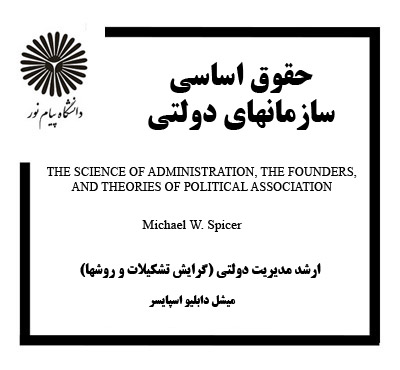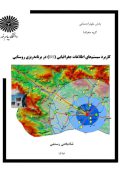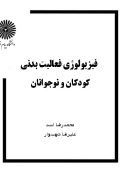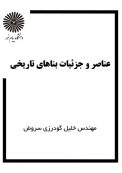THE SCIENCE OF ADMINISTRATION, THE FOUNDERS, AND THEORIES OF POLITICAL ASSOCIATION
جزوه متن انگلیسی حقوق اساسی سازمانهای دولتی نوشته میشل دابلیو اسپایسر منبع ارشد مدیریت دولتی گرایش تشکیلات و روشها
Michael W. Spicer Professor of Public Administration and Urban Affairs
Maxine Goodman Levin College of Urban Affairs
Cleveland State University
Cleveland, Ohio 44115
ABSTRACT
Drawing on the work of Michael Oakeshott, this paper seeks to examine the theory of political association underlying Luther Gulick and L. Urwick’s Papers on the Science of Administration and to contrast this theory with that underlying the Constitution. It is argued that the authors of the Papers clearly viewed the state as a form of purposive association whereas the Founders of the Constitution in large part saw the state as a form of civil association. This explains the difficulties that reformers such as Gulick faced in realizing their vision of administration within our constitutional framework.
Copyright 1998 by Muscel Dekker, Ine.
Luther Gulick and L. Urwick’s Papers on the Science of Administration (1) represent one of the most important attempts at a synthesis of doctrines in the field of public administration prior to World War II. While the Papers exhibit a variety of approaches and views, they are best known for those authors who, like Gulick and Urwick themselves, took a more classical approach to administration. Such an approach rests on a belief in the virtues of hierarchy and centralization of authority and power in the chief executive, a belief in efficiency as the central value of administration; a belief that there must exist certain principles for good administration applicable to all organizations, regardless of institutional setting; and a belief that such principles are susceptible to empirical scientific discovery and verification. These doctrines, expounded so forcefully in the Papers, formed the basis for the administrative reform movement of the time including the President’s Committee on Administrative Management, of which Gulick himself was a member. Indeed, the Papers continue to strongly influence modern efforts at administrative reform. (2)
The purpose of this article is to examine the particular vision of political association which seems to underlie the Papers, and to compare it with the vision of political association which guided the Founders of the Constitution. In doing so, the article will draw upon the political thinking of the late Michael Oakeshott, a British political theorist and philosopher. I shall argue that there is a tension between the vision of political association held by the authors of the Papers and that held by the Founders, and that this tension explains the failure of administrative reformers to reshape the administrative state along the lines of classical public administration doctrines.
حقوق اساسی سازمانهای دولتی
By the nature of political association (حقوق اساسی سازمانهای دولتی) what I mean here are the terms under which individuals understand their actions to be related to each other and to the actions of government; the terms of engagement by which individuals are associated or related to each other and to government in a political community. According to Oakeshott, there are basically two forms of political association which have dominated Western political thought, discourse, and action since the Middle Ages.(3) The first of these is a form of association in which men and women see themselves as essentially free to pursue their own interests and values but are bound together by their recognition or acknowledgment of certain rules of conduct which limit their individual spheres of action. The purpose of these rules is not to secure the achievement of any particular substantive set of purposes or objectives for the community. Neither are they aimed at securing a particular set of outcomes. Rather, their purpose is solely to define the parameters by which individuals act and interact with each other as they pursue their own particular interests or purposes, either alone or in concert with others who happen to share their interests or purposes.
Oakeshott referred to this form of association as “societas” or “civil association.” It is, in Oakeshott’s words, “a relationship in terms of non-instrumental rules of conduct. : ; not rules that specify a practice or routine purporting to promote the achievement of a substantive purpose.”(4) It is a “formal relationship in terms of rules, not a substantive relationship in terms of common action.”(5) Such rules are “more like … the rules of a game which are directions, not about how to win but about how to play, or the rules of public debate, which do not tell a speaker what to say and are wholly indifferent to any particular conclusion.”(6)
The second of these forms of political association is one in which individuals recognize themselves as bound together for the joint pursuit of a particular set of common substantive purposes or for the achievement of a particular set of outcomes. It is a mode of association in which, as Oakeshott argued, “a Many becomes One in virtue of a common substantive engagement.”(7) The central feature of this form of association is a unifying set of purposes of ends. It is what Oakeshott terms a “universitas,” an “enterprise association,” or a “purposive association.” Those rules of individual conduct which exist in this form of association are designed to elicit and facilitate individual actions in pursuit of a common purpose. They are, as Oakeshott noted, “devices favorable to the prosecution of the joint enterprise.”(8) Such rules, where they exist are “instrumental rules whose desirability lies in their propensity to promote, or at least not to hinder, the pursuit of the purpose.”(9)
The unifying purpose of association here may vary between different types of purposive associations. It may be the promotion of a set of religious beliefs, the promotion of the economic development of the community’s resources or the attainment of a socially just arrangement of resources and outcomes for each of its members. It has been in the past, according to Oakeshott, a “vision of a state as a development corporation, its members related to one another as ‘workers’ in a collective undertaking devoted to the maximum exploitation of its resources and managed by a board of directors,” but has also “displayed itself in temporary expedients to promote affluence or diminish poverty and in bursts of missionary zeal toward the world at large.”(10)
These two different forms of association, the civil association and the purposive association, imply quite different kinds of government. In a civil association, the role of government is largely to elucidate, to protect, and to enforce the rules of conduct which govern individual actions and interactions, Government is “the custodian of the loyalties of the association and the guardian and administrator of the conditions which constitute the relationship” of its members. (11) Its concern here is to keep the conversation going, not to determine what is said” and it may be termed a “nomocracy.”(12) In contrast, in a purposive association, government seeks to identify common substantive purposes or ends for a political community and to manage the actions of various individuals and other resources in the community towards the attainment of those ends. Government is, to use Oakeshott’s words, “teleocratic, the management of a purposive concern.”(13)
Oakeshott argued that these two competing understandings of political association and government have shaped the development of the modern state. While his own sympathies were clearly with the notion of a state as a civil association, he believed that the nature of the modern political state, in particular the European political state, could only be comprehended in terms of a tension between these two divergent understandings of political association. He argued that the two understandings are “both required … for the specification of the modern European state, “(14) and that “To understand a modern state . . . is to understand an ambivalent experience” and the “polarized” nature of modem political consciousness. (15)
THE “PAPERS” AND PURPOSIVE ASSOCIATION
حقوق اساسی سازمانهای دولتی
While the experience of the modern state may have been shaped by these two quite different understandings or visions of political association (حقوق اساسی سازمانهای دولتی), there seems little if any doubt as to which vision primarily shaped the Papers on the Science of Administration. They seem almost quintessentially the product of a vision of a political state as a purposive association and of government as a teleocratic institution. This teleocratic view of government becomes almost immediately evident in Gulick’s foreword to the Papers where he noted that they are addressed to those “concerned scientifically with the phenomena of getting things done through co-operative human endeavor.” There is in the Papers an assumption that the community has certain substantive purposes or ends and that it is the role of public administration to seek efficient means of carrying out those purposes or ends.
Gulick’s own contributions to the book make clear this view of political association (حقوق اساسی سازمانهای دولتی) as a community organized around a set of common purposes. Organization as “a way of co-ordination,” for Gulick, “requires the establishment of a system of authority whereby the central purpose or objective of an enterprise is translated into reality.”(16) This requires not simply a “structure of authority,” but also “the development of intelligent singleness of purpose in the minds and wills of those who are working together as a group, so that each worker will of his own accord fit his task into the whole with skill and enthusiasm.”(17) “Unity of command” is necessary here to avoid “confusion, inefficiency and irresponsibility.”(18) Public administration here, in its ideal form, was seen as a unified almost single-minded instrument designed to accomplish some given set of substantive purposes. In advancing this vision of administration, Gulick’s arguments presuppose a state organized around the pursuit of such purposes and thus reveal a view of a state as a purposive association.
Consistent with this view, efficiency, defined by Gulick as “the accomplishment of the work at hand with the least expenditure of man-power and money,” was to be taken as the “basic good” or central value of administration. (19) Gulick believed that efficiency is important because “it makes life richer and safer.”(20) Efficiency, of course, is an instrumental good, and, when applied to government, assumes the existence of a set of definable and consistent political purposes. Indeed, without the existence of such a set of purposes or ends, the whole notion of efficiency loses meaning.
Gulick’s view of the state here as a purposive association also explains why he sought to increase the role of the presidency in government. As chief executive, the presidency was seen as a political mechanism for the execution of the common purposes and ends of the state. For Gulick, the “job of the President as Chief Executive is POSDCORB.”(21) This included, among other things, “working out in broad outline the things that need to be done and the methods for doing them to accomplish the purpose set for the enterprise” and the “establishment of the formal structure of authority through which work subdivisions are arranged, defined and co-ordinated for the defined objective.”(22) Given a presumption that there exists a set of definable and consistent national purposes, it was logical that the implementation of those purposes and ends should rest with an unified executive branch under the control of the president.
Gulick’s arguments clearly imply, therefore, that there are definable and consistent substantive national purposes or ends of the state for public administrators to follow and to implement effectively and efficiently. It may be argued here that Gulick, in the Papers, was only viewing administration in purposive terms and was not implying any particular vision of association for the state as a whole. However, how one can conceive public administration in such exclusively purposive terms without conceiving political association (حقوق اساسی سازمانهای دولتی) in similar terms, while perhaps possible, is difficult to see. After all, where are the clear and consistent purposes for an efficient public administration to emerge if not from a teleocratic form of government?
Furthermore, Gulick himself made fairly explicit his own basic view of human communities as purposive associations. He observed that “There are apparently no limits to the effort mankind is prepared to make to render life more secure and more abundant through socially enforced co-ordination.”(23) Gulick conceded that lack of knowledge and administrative skills imposed limits to such “socially enforced co-ordination,” but argued that we should seek to push back such limits so as to permit a greater range of coordinated social action. He proposed that we should “advance the area of attempted co-ordination in sectors and experimentally so that the necessary skill may be gained through trial and error.”(24) He saw the “deliberate” advancement of social coordination in a community as proceeding in a wave motion, with periods of pause and consolidation after each forward move.”(25) Gulick’s vision that an increasingly broad range of human action in communities should be brought under the domain of some type of conscious and planned co-ordination, perhaps slowly but inevitably, would seem the essence of a view of political association (حقوق اساسی سازمانهای دولتی) as essentially purposive.
Gulick’s view of political association (حقوق اساسی سازمانهای دولتی) was shared to a considerable extent by his fellow authors of the papers. Henri Fayol, for example, whose 1923 Address before the Second International Congress of Administrative Science was included in the book, demonstrated a view of the state as a purposive association when he argued that the purpose of administration is “to ensure the complete execution of the will of the chief.” (26) An “essential condition for a successful operation of the Public Service,” for Fayol, is a good High Command, “(27) whose duty “is to conduct the enterprise towards its objective by endeavoring to make the best possible use of the resources at his disposal.”(28)
Urwick similarly defined organization as “the provision and arrangement of the appropriate human and material resources for a given purpose.” (29) Organization for Urwick in all areas of human action was a “technical problem.” He saw his work as providing remedies for humanity for “enormously costly failures in its capacity for purposeful association.”(30) He made clear the applicability of his work to government action, when he observed that the principles of organization could be studied “irrespective of the purpose of the enterprise… or any constitutional, political or social theory underlying its creation.”(31) This view that the principles of organization should be the same across all organizations, private or government, is itself important for it shows that, when one conceives of political association (حقوق اساسی سازمانهای دولتی) in purposive terms, then it becomes difficult, if not actually impossible, to make a distinction between government organizations and private enterprise organizations. When the community as a whole is a purposive association, private and public organizations are all teleocratic institutions and can differ only with respect to the substantive content of their purposes.
Urwick also displayed a faith in science characteristic of many of those who view the state as a purposive association. Those who see the state as capable of pursuing certain substantive ends tend to be fairly optimistic about the possibility of acquiring knowledge to aid in the pursuit of those ends. Urwick, in this vein, believed in the “possibility of a science of management” and saw it as “the only concrete hope before humanity of an ordered and satisfactory solution of the economic and social problems” which a “lack of balance” between the natural and social sciences had created.(32) He argued that such a science “must have its repercussions in politics, in government, in every aspect of human life.”(33)
This faith in the power of science to aid in the pursuit of the substantive ends of the state was even more enthusiastically expressed in the Papers by Henry Dennison who argued for the need to develop a “political science engineering.” “A nation or a state,” according to Dennison, like “a factory or business organization,” is simply “another sort of social group, living together and in no remote sense working together for some more or less definite end.”(34) Dennison called for “an engineering approach to the problems of government.”(35) The charge for Political Science, in his view, was to study the community “as a field of forces–psychological, biological, and physical” and to “determine the measures and structure of government which can be expected to use these forces and to relate them so as to bring about development in the direction of the fundamental purpose adopted by and appropriate to a particular social group.”(36)
While this view of the state as a purposive association was most clearly expressed by those authors who took a classical perspective on administration, it could be found also among other authors. Mary Parker Follett, for example, clearly rejected the authoritarian bureaucratic style of control typical of the classical approach, but did not seem to reject its vision of political association (حقوق اساسی سازمانهای دولتی) as purposive. (37) Rather, she seemed to argue for a more participatory approach to the determination of common ends. Follett saw administrative and social control in terms of a coming together of or a “unity” among the different views of different individuals involved in a particular situation. It is this unity among views which, for Follett, means “control of the situation.”(38)
With respect to the economy, Follett believed that “The period of laissez-faire is indeed over” and that industry should be coordinated by planning boards “composed of the heads of the industries themselves” and “expert economists.”(39) “To get our affairs in hand, to feel a grip on them, to become free,” she believed that “we must learn, and practice, I am sure, the methods of collective control.”(40) Follett’s language was admittedly ambiguous at some points here, but her emphasis on conscious collective control seems to reflect a view of political community as a purposive rather than a civil association. What distinguished her approach to purposive association from that of classical writers was that it was more participative and reflected perhaps a greater faith that individuals could agree on common ends.
The Papers, therefore, indicate fairly unambiguously a view of the state as a purposive association. That this should be so should hardly surprise us. Early public administration writers as a whole were strongly influenced by a type of rationalist thinking in which government was seen as an instrument for the conscious and collective exercise of reason by a community (41) Such rationalism presumes the reality of an agreed upon substantive common will or common good for a community. As a synthesis of pre-World War II thought, the Papers inevitably reflect this rationalist view of the world and hence also the view of the state as a purposive association.
It is not my purpose here to criticize per se this vision of the state but merely to indicate its dominance in the thinking of the authors of the papers. However, it is worth observing that the constitutional framework in which public administration operates reflects in large part a rather different view of political association (حقوق اساسی سازمانهای دولتی), in particular a view of the state as a civil association. This can be seen clearly when we consult the writers of those other “papers,” namely the Federalist Papers.
THE FOUNDERS’ VIEW OF POLITICAL ASSOCIATION
حقوق اساسی سازمانهای دولتی
While it is true that the Founders sought both a stronger central government and a stronger chief executive in their constitutional design, their writings do not support a view of the state as a purposive association. The Founders clearly recognized that men and women would often have different and conflicting interests and passions. James Madison argued that it was “impracticable” to assume that every citizen would have “the same opinions, the same passions, and the same interests.”(42) He noted that “As long as the reason of man continues fallible … different opinions will be formed” and that “As long as the connection subsists between his reason and his self-love, his opinions and his passions will have a reciprocal influence on each other.”(43) Alexander Hamilton similarly observed that “momentary passions and immediate interests have a more active and imperious control over human conduct than general or remote considerations of policy, utility or justice.”(44)
For this reason, the Founders were not optimistic about the possibility of cooperation among individuals towards common ends. Madison observed that “The diversity in the faculties of men… is not less an insuperable object to a uniformity of interests. “(45) He thought mankind “much more disposed to vex and oppress each other, than to cooperate for their common good.”(46) Hamilton argued that “The result of the deliberations of all collective bodies must necessarily be a compound as well of the errors and prejudices, as of the good sense and wisdom of the individuals of whom they are composed. “(47)
This emphasis on the conflicting nature of human interests and passions and on the difficulties of cooperative action suggest that the Founders would have found problematic a view of the state primarily as a purposive association in which individuals cooperate to achieve common substantive purposes or ends. Indeed, it was because of their awareness of the dangers to liberty posed by conflicting interests and passions that the Founders deliberately sought, by the use of constitutional checks on power, to render more difficult the achievement of substantive common
حقوق اساسی سازمانهای دولتی
Madison, for example, argued for the Union because he believed that a stronger central government would help check the ability of majority factions in state legislatures to achieve their common ends at the expense of minorities. He argued that “If a majority be united by a common interest, the rights of the minority will be insecure.”(48) The “security for civil rights,” for Madison, consists “in the multiplicity of interests.”(49) He noted:
Extend the sphere, and you take in a greater variety of parties and interests; you make it less probable that a majority of the whole will have a common motive to invade the rights of other citizens; or if such a common motive exists, it will be more difficult for all who feel it to discover their own strength and to act in unison with each other (50)
In this way, Madison sought consciously to frustrate the achievement of particular substantive ends by majorities in state legislatures. At the same time, Madison also argued for a separation of powers as a means of limiting the ability of majorities at the federal level to achieve their ends. A separation of powers between the legislative, executive, and judicial branches of government was necessary because “Ambition must be made to counteract ambition” (51) and “to overcome the defect of better motives” by providing for “opposite and rival interests.”(52)
Hamilton sought a strong and “energetic” executive but, outside of foreign policy, this was not generally for the purposes of executing the common will of a purposive political association. Rather a strong executive was essential to “the steady administration of the laws, to the protection of property against those irregular and high handed combinations, which sometimes interrupt the ordinary course of justice” and to “the security of liberty against the enterprise and assaults of ambition, of faction and of anarchy.”(53) The virtue of a strong executive, for Hamilton, lay in significant part in its role as a check on the ability of legislative majorities to achieve their substantive ends.
The Founders’ constitution, with its various devices for checking power, can be seen here as providing agreed upon rules of association for individuals and groups as they seek to achieve their own interests or particularistic visions of the public good within the political process. The effect of these constitutional rules is to regulate the conduct of individuals and groups within the process of policy formulation and implementation and, in doing so, to limit the power which particular individuals and groups can exert over others. As such, the Founders’ constitution can be seen as an essential part of the larger set of rules of a civil association.
The Founders’ view of the state as primarily a civil association is also clear in Madison’s assertion that “the first object of government” is the protection of “diversity in the faculties of men.”(54) He saw the “principal task of modern legislation” as the regulation of the “various and interfering interests” of individuals in the community.(55) Consistent with this nomocratic view of government was the importance which Madison attached to stability or predictability in the law so that individuals might be protected from arbitrary government actions. He noted that “An irregular and mutable legislation, is not more an evil in itself, than it is odious to the people” and saw the Constitution as a remedy for “the vicissitudes and uncertainties, which characterize the State administrations.”(56) He observed that it “poisons the blessings of liberty itself” if the laws “undergo such incessant changes that no man who knows what the law is today can guess what it will be tomorrow.”(57) Hamilton argued similarly that “inconstancy and mutability in the laws … form the greatest blemish in the character and genius of our governments.”(58) The Founders saw that stability and predictability in the laws was essential to the maintenance of a civil association in which men and women would be free to pursue their own interests and values without arbitrary interference from others.
The emphasis of the Founders here on the importance of stability and predictability in laws is clearly in conflict with a teleocratic view of government. Given a teleocratic view of government, government must be free to change laws as more effective and more efficient means are “discovered” to achieve common ends and, in doing so, must render law, to a considerable degree, uncertain and unpredictable. Friedrich Hayek saw this when he argued that if the state were to direct the individual’s actions so as to achieve particular ends, its action would have to be decided on the basis of the full circumstances of the moment and would therefore be unpredictable.”(59) In contrast, where government is seen as protecting and enforcing rules of conduct for members of a civil association, stability and predictability become of prime importance.
IMPLICATIONS
In clear contrast then to the authors of the Papers on the Science of Administration, such as Gulick and Urwick, who view the state in terms of a purposive association and government as a teleocratic institution, the Founders viewed the state primarily in terms of a civil association and government as a nomocratic institution. This tension in visions of the state is of more than theoretical interest because it helps explain why administrative reformers, influenced by a view of the state as a purposive association, have generally not been very successful in achieving their vision of a unified administrative state under the authority and direction of the president.
Despite repeated attempts by administrative reformers to increase the authority and power of the president as chief executive over the activities of administrators, the activities of public administrators remain subject also to the scrutiny, power, and influence of other branches of government, most especially the legislative branch. Public administrators remain accountable to multiple constitutional masters. (60) As James Q. Wilson has observed, the bureaucracy is not the “helpless pawn of whatever control measures the president seeks to put in place,”{61) but neither is Congress “a “principal’ that can give unchallenged direction to its ‘agent,’ the bureaucracy.”(62) Rather, as he notes, the bureaucracy “can maneuver among its many political masters in ways that displease some of them and can define its tasks for internal reasons and not simply in response to external demands.”(63)
We have, therefore, not achieved for the most part, the type of centralized, unified and supposedly efficient system of administration advocated by the authors of the Papers. That this should be so is hardly surprising in light of the discussion above. The notion, advanced in the Papers, of public administration as a unified instrument of a particular group of political leaders can only make sense within the context of a view of the state as a purposive association seeking particular common ends and purposes. However, the Founders took a rather different view of political association in their constitutional designs and so bequeathed to us a political system in which political power was deliberately divided among competing institutions as a means of checking power. As a result of this, whether or not the Founders consciously intended it, the logical result was that public administration would inevitably be subject to the competing influence and power of different branches of government rather than subject to the exclusive authority and control of any one branch.
Recognizing, as did Hegel, that “it is on the conduct of officials that there depend … the execution–or alternatively the frustration of state projects,” (64) the executive and legislative branches of government, each accorded a share of political power by the Founders under the Constitution, have each been unwilling to cede power over public administration to the other. In the struggle between the President and the Congress for control of the bureaucracy, as James Q. Wilson has argued, “every advance in the power of the President (over the bureaucracy) has been matched by a comparable advance in Congress. “(65) The inevitable result of this has been that public administration has remained answerable to different masters and is not simply an instrument to be used at will by a particular group of political leaders.
This divided allegiance of public administrators to different branches of government is seen as engendering irresponsibility and inefficiency by those who, like Gulick and his colleagues, view the state as a purposive association. However, for those who, like the Founders. share a view of the state as a civil association, the divided allegiance of public administrators to different branches of government is not necessarily a bad thing. If one regards the objectives of political actors, not as particular objectives or ends of the state as a purposive association, but rather as the objectives of particular individuals and groups engaged in a civil association, then it is not clear that any one particular individual or group of individuals should be permitted to exercise absolute control over the actions of public administrators. Rather, public administrators must be permitted substantial latitude in responding to the different and conflicting directives of different political masters.
It should be noted in closing that, while the classical orthodoxy of Gulick and others has fallen into some disrepute as the field of public administration has become more complex and ambiguous, the power of their vision of the state as a purposive association remains strong. Even now, for example, we are being urged by “re-inventors of government”(66) and by the Vice-President’s National Performance Review (67) to seek a more mission-oriented and less rule-oriented public administration. While critical of classical administration and bureaucratic structures, their intent, like Gulick and his colleagues, seems to be to create a more efficient instrument for the achievement of a particular set of ends. What this article suggests is that such reformers may well be frustrated as were Gulick and his associates in securing the adoption of their vision of public administration, because their vision of the state is at odds with the vision of a civil association which in large part guided the Founders in their constitutional design
REFERENCES
- Gulick, Luther and Urwick, L. (eds.). Papers on the Science of Administration, Institute of Public Administration, New York, 1937.
- Garnett, James L. “Operationalizing the Constitution: Olicans, Trends and Proverbs.” Public Administration Review 47 (Special Issue 1987): 35-44.
- Oakeshott, Michael On Human Conduct, Clarendon Press, Oxford, 1975, and Rationalism in Politics and Other Essays, Liberty Press, Indianapolis, Indiana, 1991.
- Oakeshott. Rationalism in Politics and Other Essays, p. 454.
- Oakeshott. On Human Conduct, p. 201.
- Oakeshott. Rationalism in Politics and Other Essays, p. 454.
- , p. 450-451.
- On Human Conduct, p. 205.
- Oakeshott. Rationalism in Politics and Other Essays, p. 451
- Ibid., pp. 452-453.
- Oakeshott. On Human Conduct, p. 202.
- , pp. 202-203.
- , pp. 205-206.
- , p. 323.
- , p. 320.
- Gulick, Luther. “Notes on the Theory of Organization,” in Gulick, Luther and Urwick, L. (eds.), op. cit., pp. 6-7.
- , p. 6.
- , p. 9.
- Gulick, Luther. “Science, Values and Administration,” in Gulick, Luther and Urwick, L. (eds.), op. cit., p. 192.
- Gulick, Luther. “Notes on the Theory of Organization,” op. cit., p. 11.

حقوق اساسی سازمانهای دولتی ارشد
| سایز |
سایز A4 پشت و رو, سایز A5 پشت و رو
|




















نقد و بررسیها
هیچ دیدگاهی برای این محصول نوشته نشده است.